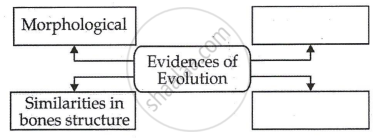Advertisements
Advertisements
Question
Which evidence of evolution is shown in the given picture? Explain the importance of this evidence.

Solution
The given diagrams depict anatomical similarities between the human hand, foreleg of the ox, forelimb of the bat, and flipper of the whale.
- Anatomical evidence are the similarities in structures and anatomy between different organisms.
- The hand of human, foreleg of ox, flipper of the whale, and forelimb of bat appear different superficially or morphologically.
- Also, the function of these structures is different in different animals.
- However, there is a similarity in the structure of bones and bony joints in the organs of these animals.
- These similarities indicate that the animals evolved from a common ancestor thus providing proof of evolution.
APPEARS IN
RELATED QUESTIONS
State the connecting links between Peripatus with Annelida and Arthopoda.
Give two examples of vestigial organs in human beings and plants.
Differentiate between homology and analogy. Give one example of each.
“Two areas of study namely 'evolution' and 'classification' are interlinked'. Justify this statement.
Differentiate between analogy and homology giving one example each of plant and animal respectively.
State a reason for the increased population of dark coloured moths coinciding with the loss of lichens (on tree barks) during industrialization period in England.
Explain with an example for the given, how the following provides evidence in favor of evolution in organisms :
Fossils
Name the scientists who Discovered the fossil of Australopithecus
Some dinosaurs had feathers although they could not fly birds have feathers that help them to fly. In the context of evolution, this means that ______
There are five animals A, B, C, D and E. The animal A uses its modified forelimbs for flying. The animal B uses its forelimbs for running whereas the animal C uses its forelimbs for grasping. The animal D can live on land as well as in water and uses its forelimbs to prop up the front end of its body when at rest. The animal E which respires by using spiracles and tracheae uses wings for flying but its wings are analogous to the modified forelimbs of animal A.
(a) What could the animals A, B, C, D and E be?
(b) Why are the forelimbs of animals A, B, C, D called homologous organs?
(c) What does the existence of homologous organs in animals A, B, C and D tell us about their ancestors ?
(d) Why are the modified forelimbs of animal A and the wings of animal E called analogous organs?
(e) State whether animals A and E have a common ancestor or not.
The organs P and Q of two animals have different structures but similar functions. On the other hand, the two organs R and S of two other animals have the same basic structure but different functions.
(a) What are the organs like P and Q known as?
(b) Name the organs like P and Q. Also name the animals which have such organs.
(c) What are the organs like R and S called?
(d) Name the organs like R and S. Also name the animals which have such organs.
You have potato, carrot, radish, sweet potato, tomato and ginger bought from the market in your jute bag. Identify two vegetables to represent the correct homologous structures.
(A) Potato and tomato
(B) Carrot and tomato
(C) Potato and sweet potato
(D) Carrot and radish
Write short notes based upon the information known to you.
Connecting link
Complete the following chart:

“Appearance of melanised moths post-industrialisation in England is a classic example of evolution by natural selection.” Explain.
With the help of diagrams, describe emasculation and bagging.
Define phylogeny.
Very short answer question.
What are homologous organs?
Short answer question.
Give the significance of fossils.
Long answer question.
Would you consider wings of butterfly and bat as homologous or analogous and why?
Explain the importance of Anatomical evidences with examples.
Similarities in the initial stages indicate the _______ evidence.
_____________ is a vestigial organ in human beings.
Name the parts shown in the diagram.
Human jaw

Complete the flowchart.

Define the evidence of evolution shown in the figure.

Observe the following images and answer the questions.

- Which evolutionary evidences are indicated in the given picture?
- How are they formed?
- Which method is used to measure their age or their time?
Biogenetic law states that ______.
Homologous organs and vestigial organs are examples of ______ type of evidence in evolution.
Study of fossils is ______.
The process of mating of individuals, which are more closing related than the average of the population to which they belong is called ______.
Fossils are generally found in ______.
While creation and presence of variation is directionless, natural selection is directional as it is in the context of adaptation. Comment.
Complete the following diagram:

What is the function of the appendix of our digestive system?
Explain natural selection with the example of industrial melanism.
Complete the following conceptual picture:

